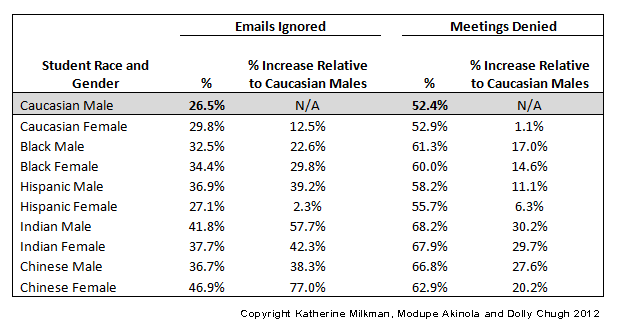Much of the talk about ending workplace discrimination focuses on gateways — that is, what happens after a woman or a minority candidate applies to college or sends in a resume for a particular job.
But some of the biggest barriers to a truly diverse applicant pool and workforce may actually be occurring at the stage just before that — what Wharton operations and information management professor Katherine Milkman and collaborators Modupe Akinola of Columbia University and Dolly Chugh of New York University call the “pathway” stage. If women or minorities are not given the same level of encouragement — or the same ability to access “insider” information — as their white male colleagues, they may be discouraged from even trying to pursue a particular opportunity, or they may start the application process at such a disadvantage that there is no chance of catching up.
In two recent papers, Milkman, Akinola and Chugh examine how this type of discrimination plays out in the world of academia. Using an experiment that explored the treatment of prospective applicants to doctoral programs, they found that professors were significantly less likely to be responsive to communication from women or minority applicants — and that the level of unresponsiveness was greater within academic disciplines that tend to pay more, and at private institutions, where faculty salaries are higher on average.
“In a lot of industries, you need insider information to successfully break in,” Milkman says. “There are a lot of things that an insider knows that an outsider wouldn’t, and an applicant who receives encouragement and mentoring is therefore at a huge advantage.”
The papers, Heterogeneity in Discrimination? A Field Experiment, and one published in the journal Psychological Science titled, Temporal Distance and Discrimination: An Audit Study in Academia, were inspired in part by Milkman’s personal experience as one of just a few female PhD students spending time in the computer science and economics departments at Harvard. She also points to an enlightening study by Harvard economist Sendhil Mullainathan and University of Chicago economist Marianne Bertrand, who in 2004 explored race and gender biases in hiring by sending out resumes in response to ads for entry-level jobs in Boston and Chicago. The resumes were identical except for the candidate’s name, which was designed to indicate the applicant’s race and gender. Bertrand and Mullainathan found that white job candidates received a 50% higher callback rate for interviews than identical black job candidates.
“It was an amazing study, but it only scratches the surface of what’s going on,” Milkman notes. “The study showed that discrimination remains a problem in entry-level hiring. But I wondered: Is it still an issue in organizations where people are particularly focused on trying to increase diversity? Is it just as prevalent in highly educated, highly paid industries?”
In addition to Milkman’s personal interest in how race and gender bias may play out in academia, she notes that the setting is also unique in that basic demographic and contact information about professors is easily accessible on the Internet, and further, faculty are often contacted by students when they are thinking about applying to a particular doctoral program. “I get e-mails all the time from people who are hopefuls. It’s a really competitive industry and the way they figure out their chances of admission is to contact professors and ask for our advice and support,” she says. “They want to know if they have a shot. [Our] response can make all the difference.”
Milkman and her co-authors designed an experiment in which they sent e-mails to 6,500 professors at 258 U.S. universities representing 89 different disciplines. All of the e-mails contained meeting requests from prospective doctoral students. But the names of the fictional prospective students were randomly varied to indicate whether the sender was a man or a woman, or if he or she was white, black, Hispanic, Indian or Chinese. In some of the requests, the student asked if he or she could come in for a meeting that same day; others asked to meet in a week.

Varying the timing of the requests was a particularly important aspect of the research, Milkman says. “Timing is one of the biggest contextual factors known to shift behavior,” she notes. “When you’re focused on the now, you’re really focused on the how and not thinking about the why…. Discrimination really comes out when people are thinking about why to meet with someone. When you have a lead time of a week, [your answer] isn’t only based on looking at the calendar and thinking, ‘Can I fit this in?’ It’s based on your evaluation of whether the meeting is worthwhile.”
Indeed, the researchers found that there was virtually no difference in the rate of response when prospective students asked for an immediate meeting. But when they tried to schedule one in a week, white males were 26% more likely to successfully schedule a meeting and 16% more likely to receive a response. While white males were more likely to get a response if they asked to meet in a week rather than the same day, female and minority students had a better response rate when they asked to meet immediately. The response rate for women and minorities was 14 percentage points higher at public institutions than at private schools. Further, a $13,000 increase in a faculty member’s salary was associated with a four percentage point drop in the email response rate to women and minorities, but faculty salary had no such effect on white males.
‘Any Ambiguity Can Be Used Against You’
All faculty members who responded “yes” to the meeting requests got an e-mail minutes later saying the student couldn’t make it. All were sent messages two weeks after the experiment telling them that the queries were part of a study. Reactions were mixed. While some thanked the researchers for examining the issue of discrimination, others were upset because they felt the methods used were intrusive and wasted their time.
“Some were certainly worried that they would be labeled as discriminating,” even when they had practical reasons for not responding, such as being out of the country when the message came, Milkman says. “Our study was set up very intentionally to prevent the identification of any individuals as having done something wrong…. It’s the overall patterns that tell us whether discrimination exists, but there’s not any one person we can point to and say, ‘They did the wrong thing.’ Lots of people have valid reasons for not responding. But there shouldn’t be more valid reasons for people not to respond to a message received from an African-American student or an Asian student than to a message received from a white student.”
Based on her findings, Milkman offered two pieces of practical advice for students or job candidates. “We found that minority students got a better response from minorities of their race … so one prescription would be that if someone in that department shares your identity, they are more likely to be an advocate or willing to help you and less likely to discriminate,” Milkman says. “Another prescription is to not leave any ambiguity about your quality as a candidate. One reason why people discriminate is that they don’t think you’re going to be as good of a candidate, so show that you are — attach your CV, say whom you’ve worked with. Any ambiguity can be used against you.”

But Milkman suggests that the more important takeaways are for managers, many of whom may believe it is enough to emphasize diversity when looking over resumes or conducting interviews. Few probably consider the information-gathering phase most job candidates go through before throwing their hats in the ring. “Don’t just think about solutions at gateways,” she says. “Also think about having rules of thumb in place at the encouragement stage. If people in your organization are getting requests for assistance from potential applicants, instead of just responding with their gut instinct, there should be a policy in place for how to handle those requests.”
Admissions directors and hiring managers often have a specific idea in mind of how a successful applicant should frame his or her resume, meaning that those who know what to do have an edge over like-skilled candidates who don’t, Milkman points out. “How do we level the playing field? If we can eliminate opportunities for bias to seep in, then we’re getting closer to leveling the playing field. This research highlights that bias is still seeping in — it’s still there.”
The paper has already changed the way Milkman responds to prospective students who seek out her advice. “I used to just hit ‘delete’ if I didn’t know the person. I did not respond to those emails,” she says. “I have completely changed my behavior. Now that I have done this study, I know that this is where subtle discrimination can seep in. I now try to respond uniformly across the board to everyone.”



